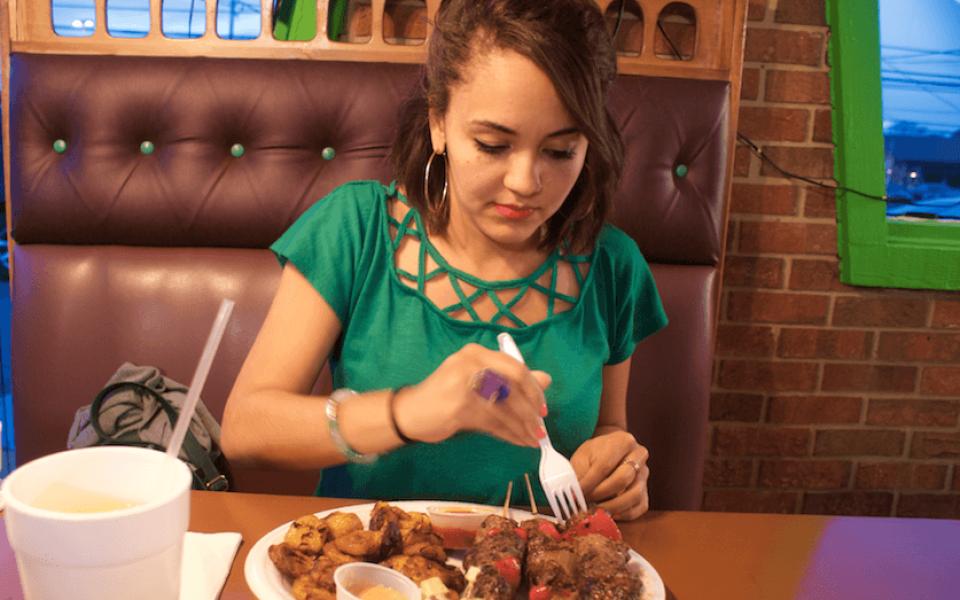by Eric Ginsburg
When longtime Village Voice food critic Robert Sietsema wrote his enthralling book, New York in a Dozen Dishes, he chose something called “thiebou djenn” as No. 4.
The meal featuring fish, rice and vegetables is usually just called “cheb” for short, he wrote, and is known as the national dish of Senegal. And though the first version of the flavor-packed, prep-intensive meal he found in New York the ’80s was stripped down, Sietsema still welcomed it and, later, dubbed it among this culinary capital’s most important.
It wasn’t until 1993, he writes, that “a few full-blown Senegalese restaurants” started opening, particularly in Harlem and Fort Greene. Sietsema lists the four best places to find cheb in New York — the top two both on West 116th Street in Manhattan — and I figured I’d need to wait for a trip north to try this celebrated meal.
That’s because African restaurants seem to struggle in Greensboro. Despite the apparent success of Taste of Ethiopia and downtown Egyptian restaurant Koshary (which, by the way now has a lunch buffet that’s worth checking out), most African restaurants here don’t fare as well. You may remember African Continental Cuisine; I only made it in to eat once before the restaurant that looked to be a one-man operation closed.
There don’t appear to be any African restaurants in neighboring Winston-Salem or High Point, though both seem to have African markets, and in nearby Durham, there’s tasty cuisine at the Palace International hailing from far-flung nations including Kenya and Zimbabwe.
But none of these restaurants with strong and moderate East African emphases respectively brought me any closer to cheb. Guilford County’s demographics didn’t make it look much more hopeful; the county’s largest African immigrant and refugee communities hail from Nigeria and Sudan, according to the Center for New North Carolinians at UNCG, while just 500 residents hail from all West African nations including Senegal.
So when I drove down Greensboro’s West Market Street — on my way to grab dinner with friends at Da Sa Rang Korean restaurant by Super G (try it and thank me later) — and saw the newly opened Marie’s African Cuisine, I didn’t even have cheb on my mind.
But the other night when I walked in with my girlfriend Kacie, there it was, thiebou djenn, on the back of the dinner menu.

©
Sietsema describes a cheb where veggies are stuffed inside the fried fish, and a plate loaded with a wide array of vegetables when he first tried the dish in Senegal, but noted that, at least initially, Senegalese immigrants scaled it back for New York restaurant service.
The same is true of the cheb at Marie’s — browned fish, bones still intact but served without the head or tail, prepared with a massive pile of reddish Jollof rice and topped with a few cooked and starchy root vegetables. And, just like Sietsema described, the cheb here comes with what looks like a bit of canned tomato for taste, though the dish does better with a squeeze of the lime wedge provided.
Jollof rice is popular West African food generally made with palm oil and tomato paste, along with several spices, and is thought to be a descendent of paella, possibly from Portugal in particular. (Senegal and Portugal are relatively close, if you look at a world map, given how far north the western coastal nation is.) Some believe Jollof rice is a progenitor of jambalaya, which after eating it, I have to say makes sense.

©
The rest of the menu at Marie’s is meat heavy, unless you don’t count fish; otherwise it’s a rice couscous and collard greens plate called “dambou,” which appears to be from Niger. Our server recommended the beef kabobs, which come with sweet plantains, and I’m glad Kacie took her up on it. Though two hot sauces that came with it were overpowering, the seasoned beef paired with onion and pepper was tasty and also familiar.
Do not leave Marie’s without trying the house lemonade, which deserves a more unique name considering it contains ginger, pineapple and mint as well as a little vanilla and sugar. In fact, if you somehow made it this far into the article but are the kind of person who’s still probably going to go eat a hamburger for lunch tomorrow, just go ask the folks at Marie’s for a gallon of this stuff to go and sub it out for your sweet tea. It’s not as overwhelmingly sugary and tastes incredibly well balanced and satisfying.
 But if you’re up for trying something new, go ask for the cheb. There are other choices — from fried turkey tail to steak sautéed with peas and served with French bread, and even a ground beef sandwich with habanero peppers and mayo that sounds more like Mexican food — but likely none that are as quintessentially Senegalese.
But if you’re up for trying something new, go ask for the cheb. There are other choices — from fried turkey tail to steak sautéed with peas and served with French bread, and even a ground beef sandwich with habanero peppers and mayo that sounds more like Mexican food — but likely none that are as quintessentially Senegalese.
Did I mention how good it tastes, or that it’s easy to remove the fish’s bones in one skilled swoop? You’ll like it, and almost as importantly, you’ll make it that much more likely that we won’t have to go to New York just to grab some cheb in the future.
Visit Marie’s African Cuisine at 4631 W. Market St. (GSO) or visit mariesafricancuisine.com.
Join the First Amendment Society, a membership that goes directly to funding TCB‘s newsroom.
We believe that reporting can save the world.
The TCB First Amendment Society recognizes the vital role of a free, unfettered press with a bundling of local experiences designed to build community, and unique engagements with our newsroom that will help you understand, and shape, local journalism’s critical role in uplifting the people in our cities.
All revenue goes directly into the newsroom as reporters’ salaries and freelance commissions.





Leave a Reply